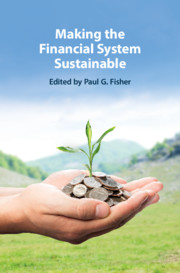Book contents
- Making the Financial System Sustainable
- Making the Financial System Sustainable
- Copyright page
- Contents
- Figures
- Tables
- Boxes
- Contributors
- Foreword
- Preface
- Introduction
- 1 Capitalism Meets Multilateralism
- 2 Public Meets Private
- 3 Central Banking and Climate Change
- 4 Sustainable Finance and Prudential Regulation of Financial Institutions
- 5 Transparency and Accountability Standards for Sustainable and Responsible Investments
- 6 Environmental Risk Analysis by Financial Institutions
- 7 Sustainable Governance and Leadership
- 8 ESG Risks and Opportunities
- 9 Active and Responsible
- 10 Passive-Aggressive or Just Engaged
- 11 Financing a Just Transition
- 12 Sustainable Finance for Citizens
- 13 Individual Impact Investors
- 14 Strengthening Green Finance by Better Integrating the Social Dimensions in the European Union’s Sustainable Finance Laws
- Index
- References
9 - Active and Responsible
A Cost-Efficient Model for Integrating Sustainability
Published online by Cambridge University Press: 30 October 2020
- Making the Financial System Sustainable
- Making the Financial System Sustainable
- Copyright page
- Contents
- Figures
- Tables
- Boxes
- Contributors
- Foreword
- Preface
- Introduction
- 1 Capitalism Meets Multilateralism
- 2 Public Meets Private
- 3 Central Banking and Climate Change
- 4 Sustainable Finance and Prudential Regulation of Financial Institutions
- 5 Transparency and Accountability Standards for Sustainable and Responsible Investments
- 6 Environmental Risk Analysis by Financial Institutions
- 7 Sustainable Governance and Leadership
- 8 ESG Risks and Opportunities
- 9 Active and Responsible
- 10 Passive-Aggressive or Just Engaged
- 11 Financing a Just Transition
- 12 Sustainable Finance for Citizens
- 13 Individual Impact Investors
- 14 Strengthening Green Finance by Better Integrating the Social Dimensions in the European Union’s Sustainable Finance Laws
- Index
- References
Summary
This chapter explores the rationale for a pension fund to integrate sustainability in its investment analysis and decisions, and why engagement is an important tool for an active and long-term investor in creating value for beneficiaries. Based on our experiences this does not neccessarily carry the higher costs traditionally associated with active management, but it will put higher demands on asset managers and analysts to understand and translate new data and information into the fundamental financial analysis. In a time where increasing capital is being allocated to passive index strategies, we argue that active and long-term owners foster corporate accountability and a broader concept of value creation. We stress the importance of developing in-house capacity for engagement and stewardship, as this enables leverage on key industry insights, while at the same time recognising when investor collaboration towards a common objective is more efficent.
Keywords
- Type
- Chapter
- Information
- Making the Financial System Sustainable , pp. 196 - 213Publisher: Cambridge University PressPrint publication year: 2020

